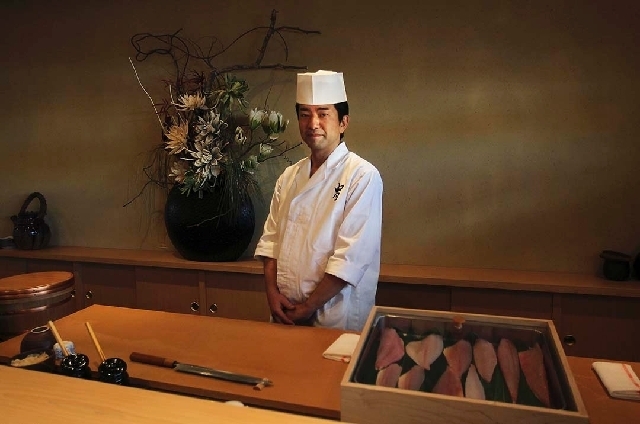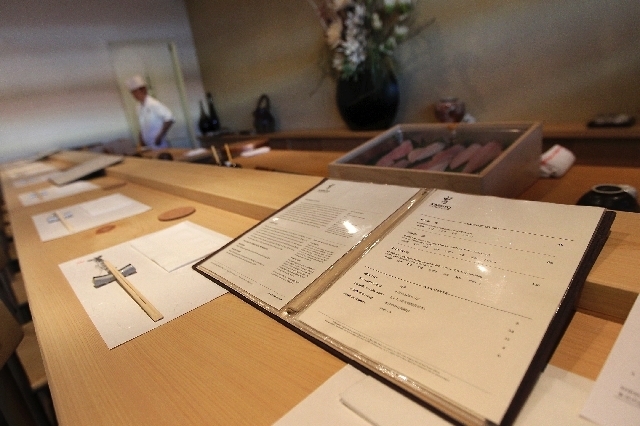Even with no sign, Las Vegas sushi restaurant prospers
Simple.
That is the best way to describe the restaurant. There are no art pieces or photos hanging on the walls. The only noticeable decoration is a plant in a giant pot sitting behind the sushi bar.
There are no signs advertising the restaurant either. There is not even a sign located outside of the restaurant until 15 minutes prior to opening when a small portable sign is placed by the entrance. Yet somehow people seem to know about Kabuto Edomae Sushi Restaurant at 5040 W. Spring Mountain Road #4.
It has all been through word of mouth Genichi Mizoguchi, chef and co-owner of the restaurant, claims.
“We serve traditional Tokyo-style sushi. If we had a big sign advertising that this was a sushi restaurant, it would not be good. A lot of customers would expect different types of sushi, like the California roll or the spicy tuna roll,” Mizoguchi said. “This is traditional-style sushi. If we don’t advertise, then the right customers will come.”
Mizoguchi, along with his partner Takashi Segawa, opened the restaurant in May of last year. Mizoguchi said he chose to open his first restaurant in Las Vegas because he wanted to attract customers from all over the world.
“Even though we did not advertise it was not a big risk for us,” Mizoguchi said. “I was confident that as long as we served really great meals everything was going to be fine.”
Mizoguchi moved from Tokyo to San Francisco in 2002. In 2005 he moved to New York, where he worked as the executive chef at Megu, a Japanese cuisine restaurant.
Mizoguchi is a second-generation Edomae sushi master. His father, Koichi Mizoguchi, owned an operated Senri Sushi Restaurant in Tokyo for 35 years where he trained his son in the art of sushi making.
Unlike the well-known Maki rolls, Edomae sushi is a particular type of sushi prepared with fresh fish, warm vinegar-flavored rice and served one piece at a time.
Mizoguchi’s 25 years of training have paid off. He has won a bronze medal at a Tokyo sushi contest and obtained a Tokyo blowfish license. Last year, Kabuto made Bon Appétit’s top 50 best new restaurants list.
Kabuto only serves three meals: the nigiri course for $48, the yoroi course for $80 and the kabuto course for $120. Each course consists of two main items, either sashimi, small single bites of raw or marinated fish, or nigiri sushi, raw or marinated fish served on warm vinegar rice.
“Kabuto means samurai helmet,” Mizoguchi said. “I named it that because samurai helmet represents a strong imagination.”
Mizoguchi designed the restaurant to be similar to a traditional Tokyo sushi restaurant.
The restaurant operates with 12 employees and has a seating capacity of 22 people, 10 seats at the sushi bar and three tables.
“I want to see everyone’s faces. I want to be able to see their expressions and see that they are well-attended,” Mizoguchi said.
Customers can either choose their sushi a la carte or can ask for the chef’s choice. Among the items that may be featured are premium fatty tuna, sweet shrimp, Japanese mackerel, sea eel and salmon roe.
Mizoguchi gets his fish delivered fresh every day from Tsukiji fish market in Tokyo, so the menu changes daily based on what fish was caught.
“I buy my fish from the same fish market that Jiro (from the documentary Jiro Dreams of Sushi) buys his fish, the only difference is that he brings back more sales than I do,” Mizoguchi said.
According to the chef, the biggest challenge of operating the restaurant is dealing with the imported fish.
“I get phone calls from Japan at 5 a.m. in the morning to get the latest information about the fish,” Mizoguchi said. “Sometimes they don’t get the fish we want, and we have to change the menu.”
Mizoguchi claims that his restaurant is doing very well, and he even has future plans to open a second restaurant in California.
According to Azuma Manandhar, head server at the restaurant, customers range from lawyers to poker players and couple who are celebrating special occasions.
“I absolutely enjoyed the food. You can just taste the freshness of the food,” said Loan Le, 26, who visiting Las Vegas from Westerly, R.I.
Customer comments are key to the restaurant’s success.
“Most of our customers found out about this restaurant through word of mouth and Yelp was a big help,” Manandhar said.
What is the secret to their success?
“You just have to have the best fish, the best rice and a lot of passion,” Mizoguchi said.
“The beauty of this restaurant is in its simplicity,” Manandhar added.
Contact reporter Sandy Lopez at slopez@reviewjournal.com or 702-383-4686.














